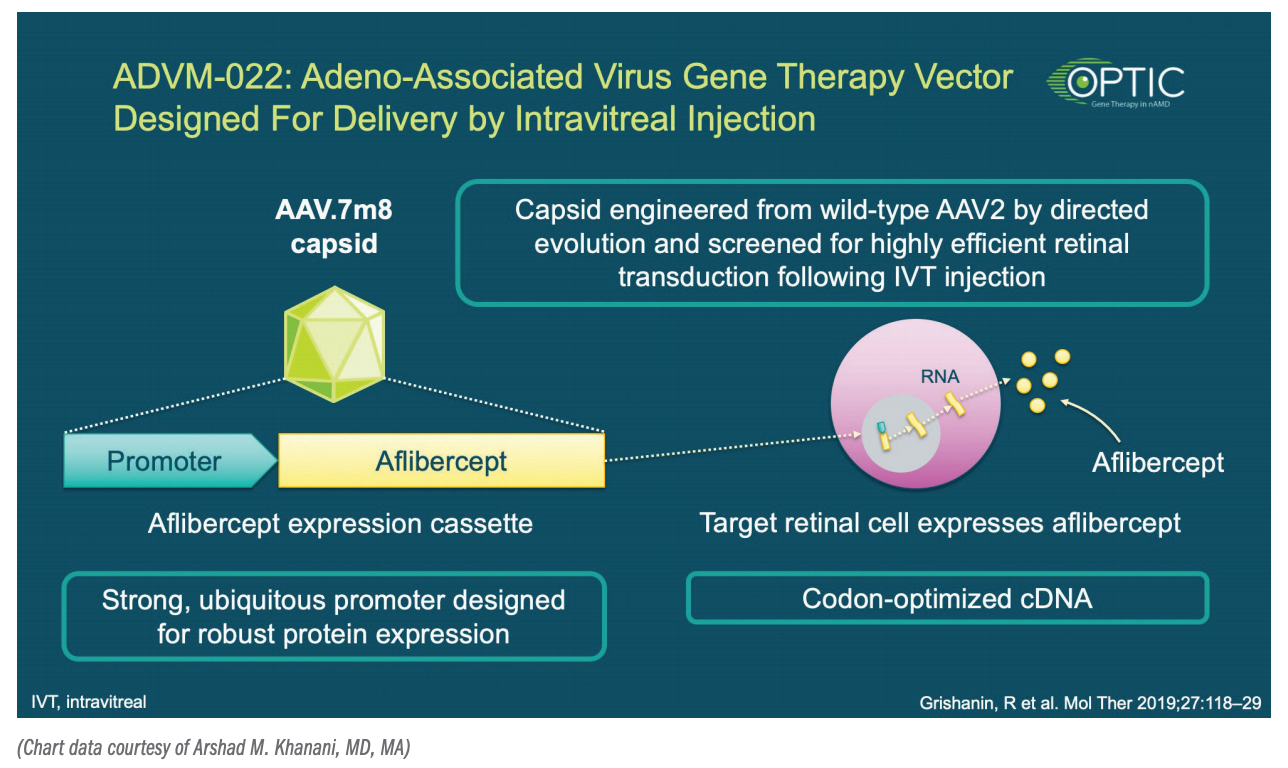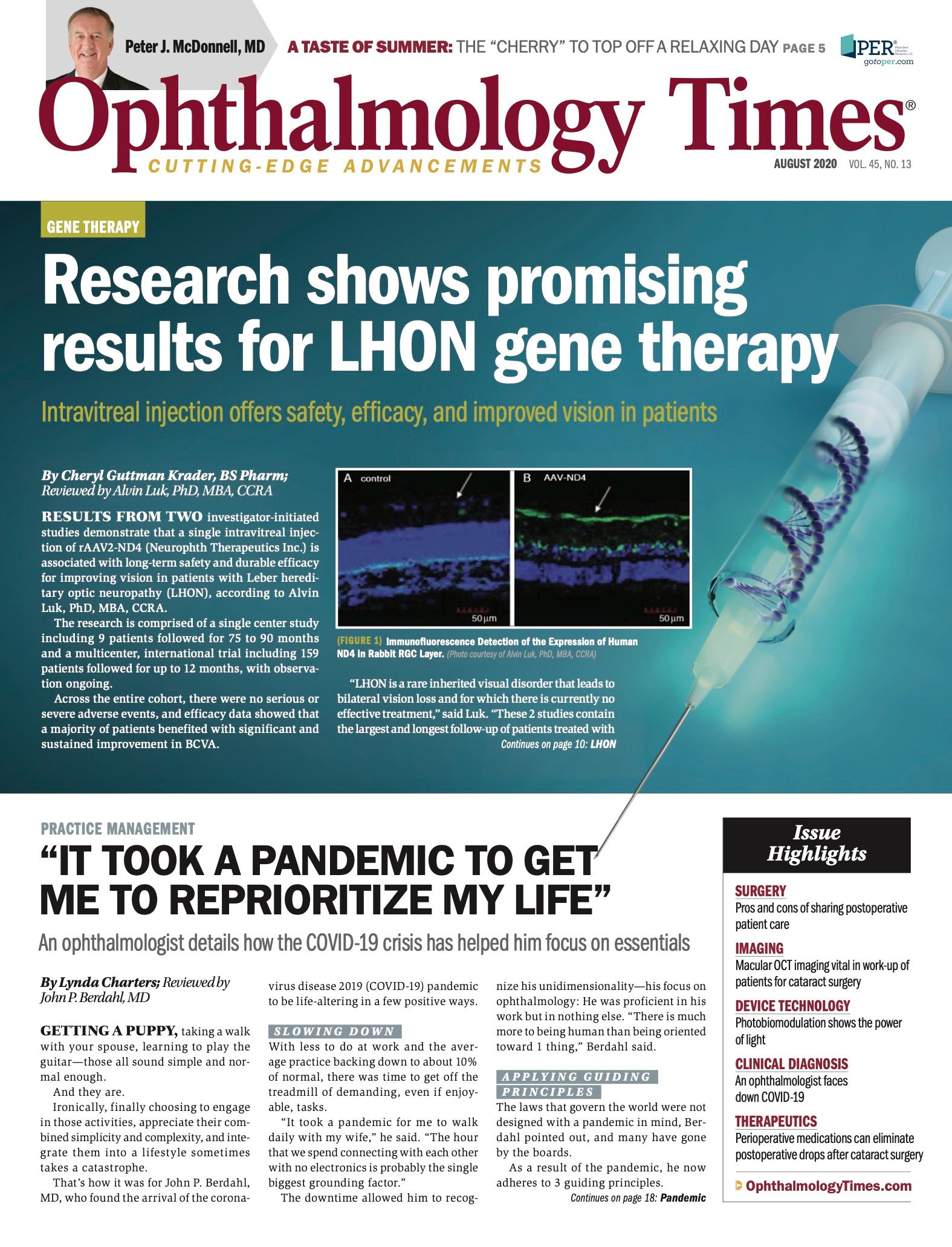Publication
Article
Digital Edition
Phase 1 trial investigating novel gene therapy for neovascular AMD
Author(s):
Candidate continues to demonstrate encouraging safety, tolerability, and efficacy

This article was reviewed by Arshad M. Khanani, MD, MA
Analyses of data from OPTIC (NCT03748784), a dose-ranging phase 1 study, show that intravitreal ADVM-022 (AAV.7m8-aflibercept gene therapy, Adverum Biotechnologies), a gene therapy vector designed to provide long-term aflibercept expression, shows promise for treating neovascular age-related macular degeneration (nAMD) with a greatly reduced injection burden compared with existing options, according to Arshad M. Khanani, MD, MA.
“With data available from 21 patients across 3 dosing cohorts, ADVM-022 continues to be well-tolerated. Intraocular inflammation that primarily affects the anterior segment occurs, but it appears to be well managed with topical steroids,” said Khanani, the director of clinical research at Sierra Eye Associates in Reno, Nevada, and a clinical associate professor of ophthalmology at the University of Nevada, Reno.
Related: ASRS 2020: PDS with ranibizumab signals paradigm shift in treatment of neovascular AMD
“The data from OPTIC also indicate that ADVM-022 has robust dose-related efficacy, suggesting that this intravitreal therapy has the potential to improve real-world vision outcomes in nAMD by addressing the unmet need for an in-office approach that will provide long-term control of VEGF-driven disease activity,” Khanani said.
In a presentation for the Association for Research in Vision and Ophthalmology (ARVO) 2020 annual meeting, Khanani reported data for 3 of 4 patient cohorts in OPTIC.
The results were based on analyses of data collected through April 1, 2020, and offered a first look at outcomes in cohort 3.
Related: Intravitreal gene therapy holds promise for novel wet AMD treatment

Study design
OPTIC is a 2-year multicenter study enrolling patients who were previously treated for nAMD and demonstrated a meaningful response but required frequent injections.
Cohort 1 enrolled 6 patients who received the ADVM-022 dose (6x1011vg/eye) with a 13-day course of oral steroid to prevent intraocular inflammation.
Patients in cohorts 2 (n = 6) and 3 (n = 9) were treated with 2x1011 vg/eye ADVM-022 and a 13-day oral or 6-week topical course of steroid, respectively.
A single patient has been enrolled in cohort 4, which is investigating the higher dose of ADVM-022 with topical steroid prophylaxis.
Patients receive a single injection of ADVM-022 and are given rescue treatment with intravitreal aflibercept based on strict protocol-defined criteria.
Related: Characterizing localized retinal layer changes in AMD
At enrollment, patients had received an average of over 9 intravitreal anti-VEGF injections in the previous year and had a mean best corrected visual acuity (BCVA) of approximately 65 letters.
According to the research, the mean central subfield thickness (CST) across the first 3 cohorts ranged from 308 to 472 µm, with the patients in cohort 3 having the thickest average CST.
Primary outcomes
Safety and tolerability are being investigated as the primary outcomes in OPTIC. So far, ADVM-022 has been well tolerated, Khanani noted.
No patients have experienced any serious or systemic adverse events (AEs) attributed to the treatment. The most common AE has been low-grade intraocular inflammation.
Two patients experienced elevated intraocular pressure (IOP) that was successfully managed with topical treatment in 1 patient and resolved spontaneously in the other, who was already on a topical IOP-lowering medication.
Related: Glaucoma 360: Lowering IOP using the MIMS solution
“There has been no clinical or fluorescein evidence of retinal vasculitis, retinitis, or choroiditis,” Khanani said. “Although the duration of follow-up is shorter in cohort 3, we are encouraged that the longer prophylactic steroid eye-drop regimen is showing evidence of minimizing early ocular inflammation, with fewer ocular adverse events being reported.”
Results from cohort 1 showed that no patient needed rescue treatment.
After a median follow-up of 60 weeks, BCVA had decreased by an average of 2.7 letters from baseline and mean CST had improved by 26.2 µm.
“The loss of BCVA is attributed to a single patient who experienced a retinal detachment that was unrelated to the study treatment,” Khanani explained.
Khanani noted median follow-up of 36 weeks is available for cohort 2, and this subgroup had a mean decrease of 2.8 letters from baseline BCVA.
Four of 6 patients remained rescue-free, and BCVA among the rescue-free patients had improved by an average of 2.3 letters from baseline.
According to the research, mean CST improved by 40.8 µm for the entire cohort and by 30.0 µm in the 4 eyes that were rescue-free.
Related: Vision-related quality of life: Impacts of advanced AMD
Data were analyzed from the first 5 patients treated in cohort 3 who had completed 20 weeks of follow-up. At 20 weeks, 4 patients were rescue-free. BCVA was improved by 6.8 letters considering all 5 patients and by 8.8 letters for the rescue-free subgroup.
Khanani conclued that the mean CST improved by 137.8 µm for the entire group and by 149.8 µm among rescue-free eyes.
Read more by Cheryl Guttman Krader
--
Arshad M. Khanani, MD, MA
e:arshad.khanani@gmail.com
Khanani is a consultant to and receives grant support from Adverum.

Newsletter
Don’t miss out—get Ophthalmology Times updates on the latest clinical advancements and expert interviews, straight to your inbox.




